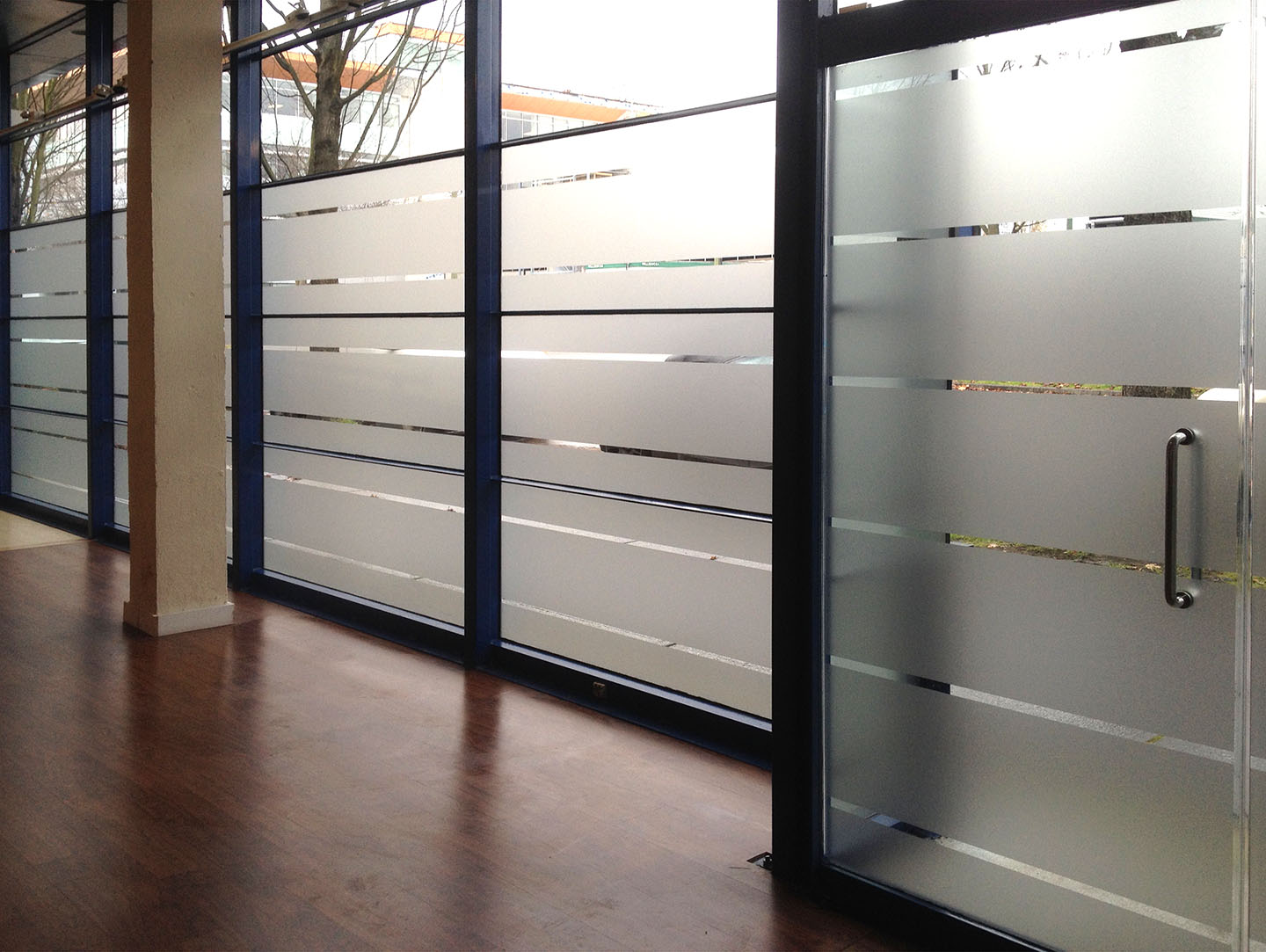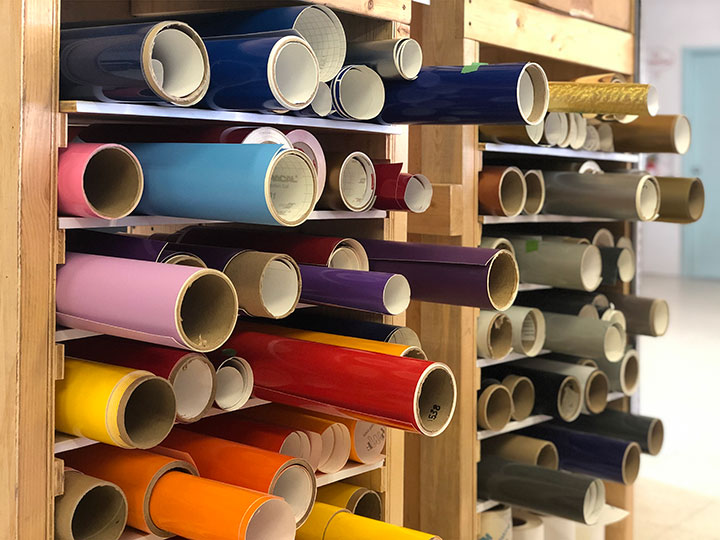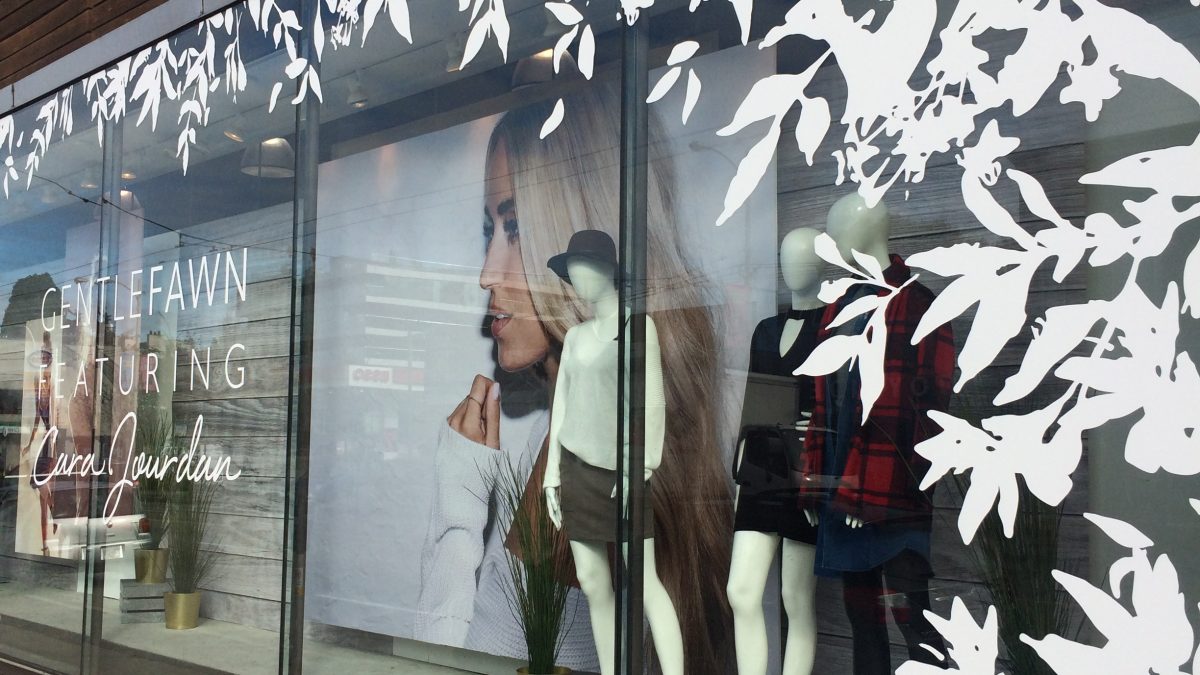
Frosted Films and Etched Glass
February 23, 2014Cut vinyl materials offer many opportunities beyond traditional lettering and graphic communication. While vinyl cutting has been around for a while, I am excited to see many new and innovative materials and applications. Vinyl graphics are now used extensively for creative expression and messaging. Use it both as a finished medium and as a value-added tool for craft and design processes.

So what makes cut vinyl so great? It combines cost-effectiveness with a decent level of finishing. The vast number of vinyl cutting material options also makes it an attractive and versatile medium. Ranging from durable outdoor materials to more decorative indoor materials, cut vinyl has more uses than one might typically think.
Signage Applications, Lettering, and Cut Vinyl Graphics
Adhesive vinyl is most often used for creating signs. Vinyl lettering and graphics are cut using a plotter and then transferred to the final surface. There are two main types of vinyl material: calendared vinyl and cast vinyl.

Calendared vinyl is a good choice as a general purpose vinyl for most applications including graphics and lettering for both outdoor and indoor use. A smooth surface is preferred for proper adhesion and longevity. Calendared vinyl is easier to apply than other vinyl as it is slightly thicker, less flexible and more manageable. It comes in several levels of performance ranging from 1 to 7 years. It is often less expensive than many of the other vinyl materials but offers bold saturation and many colour options.
A higher performance material is cast vinyl. It is a thinner and more flexible material with better adhesion that is suitable for both smooth and irregular surfaces. Because is it more flexible, it requires a little more attention during application. Due to its thinness, however, it integrates seamlessly with the surface below, often resembling a painted finish from close up. Cast vinyl is more expensive, but offers a broader array of colours and can have a performance rating of up to 12 years. It is ideal for outdoor applications and is used extensively on vehicles due to its durability and conformity.
Light Filtering and Translucent
There are several vinyl material options to filter light, including ‘block out’ vinyl that has a black adhesive backing to stop the light. Both calendered and cast vinyl have a small amount of translucency. Lighter colours will allow more light to pass. Translucent cast vinyls allow more light to pass for a higher quality light filtering effect. They are available in a range of colours and recommended for backlit signage applications or to create ambient lighting effects.
Decorative window films come in a range of frosted, etched and tinted glass effects and can be used as cut vinyl materials. They are an affordable choice for indoor designs but also offer good outdoor durability. These are often used in large sheet applications for light control, privacy films, and decorative glass effects. For large filtering or privacy vinyl, hand trimming and cutting may be all that is necessary, but frosted types of vinyl can be beautiful for subtle cut patterns, signage and lettering.
Decorative and Specialty Cut Vinyl
There are a multitude of decorative vinyls on the market today. These really extend the applications of cut vinyl materials into decorative and functional interior elements. They can also create unique and artistic signage elements and logos. From realistically textured metal finishes to wood grains and wallpaper patterned vinyl, use these to make beautiful lettering and graphic elements for both commercial and home accents. Many of these decorative vinyls are not recommended for outdoor use though as they have varying levels of weather resistance.
Adhesive chalkboard vinyl is available and can be cut by hand or with a vinyl cutter to create unique and functional surfaces in kitchens, offices and kid’s rooms. Dry erase and mirrored vinyl can also be used in similar applications. You can save a lot of time in comparison to similar paint processes that require prepping, painting, mounting, and clean up.
Low Tack Vinyl
Low tack vinyl is great to use on walls in domestic applications. As a removable vinyl, it is great for graphics and doesn’t require a lot of commitment. Plus, you don’t have to worry about damaging any fragile surfaces. Longevity and durability are somewhat unpredictable though as the adhesive is comparably low. Use caution with uneven surfaces and ensure you give your surface a cleaning before. Wall graphics, wall art, and decorations are good applications.
Paint and Screen Printing Masks
Paint masking stencil vinyl can be used for a variety of paint applications. It is available in a few matte colours and as a transparent film for easy positioning. The adhesive is pressure sensitive and low bonding for easy release after painting. This works well for both spray paint and hand paint applications leaving crisp and accurate edge detail without risk of paint bleeding.
Regular adhesive vinyl can be used for screen printing. Eliminate the need for a large messy studio space if you wnat to try short-run printing. Photo emulsion, light curing, screen cleaning, and their associated chemicals can all be eliminated.
Cast vinyl is best suited to screen printing as it is thinner and more adhesive. You will have less of an edge to squeegee over and less opportunity to damage the vinyl. It is recommended that the decal be placed on the top of the screen so the screen makes direct contact with the paint substrate. Screen printing with vinyl decals is best utilized for shorter print runs as the decal eventually degrades. You are also limited by the amount of detail that a vinyl cutter can reproduce in your design (tiny bits might be a problem).
Sandblasting and Etching Masks
Sandblasting vinyl mask is available for sandblasting glass, metal, wood, etc. The material is resistant to abrasion and comes in varying thicknesses depending on the aggressiveness and depth of material removal necessary. Specialty mask vinyls can be sourced that are resistant to higher temperatures and various chemicals such as in powder coating, heat burning and chemical etching processes. Depending on the application, regular sign vinyls can sometimes get the job done.
